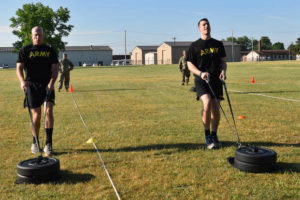
Written By Fall 2021 M-VETS Student Advisor Ty Delgado.
In June, 2019, the U.S Army introduced the Army Combat Fitness Test (ACFT), a replacement to the forty-year-old Army Physical Fitness Test (APFT). What has followed has been a slew of questions and controversies affecting current servicemembers and future veterans alike. Amid this tense transition, one of the most prominent questions asked by soldiers is “can I really be kicked out for this?” The short answer is “yes.”
The ACFT is a six-event, hour-long physical fitness test used to assess soldiers’ readiness for combat, suitability for advancement, and eligibility to remain in the Army. Under its newest version, a passing score on the ACFT requires deadlifting 140 pounds, throwing a ten-pound ball 4.5 meters, performing ten hand-release pushups in two minutes, performing a sprint-draft-carry routine in three minutes, bringing your knees to your chest while performing a pullup, and running two miles in twenty-one minutes.[1] This compares to the old APFT, which for an average age, male soldier required thirty-nine pushups in two minutes, forty-five sit ups in two minutes, and running two miles in seventeen-minutes.[2]
The ACFT began development in 2013 with the goal of better replicating basic tasks that a soldier should expect to perform under high-stress situations.[3] This largely means testing a wider array of muscle groups as compared to older standards.[4] The ACFT’s first, “1.0” version was announced in June, 2019, and was implemented in October of that year.[5] ACFT 1.0 was the product of sixty-three army units performing test runs as part of “Phase 1” of development.[6] The ACFT’s second version was introduced a year later and the ACFT 3.0, its current version, came out in April, 2021.[7] Compared to earlier versions, ACFT 3.0 adds planks as an alternative test of core strength and explores using gender-based standards to assess soldiers for purposes of advancement, such as promotions and professional education opportunities.[8]
The ACFT officially replaced the old APFT as the Army’s physical fitness test of record on October 1, 2020.[9] However, full implementation is on hold until April, 2022, due to COVID-19 and a Congressionally-mandated study.[10] Old APFT scores are therefore still valid until March 31, 2022, and “[n]o administrative actions . . . will be taken against a Soldier based on failing the ACFT until further guidance is published by the [Assistant Secretary of the Army].”[11] This for now means no ACFT-based separations and no impact on promotions or benefits.[12]
Despite its effort to improve Army fitness, the ACFT has sparked significant uproar since its inception. Many soldiers and observers argue that the old APFT, consisting of pushups, sit ups, and a two-mile run, was perfectly adequate for assessing soldier fitness.[13] Critics also argue that the ACFT, requiring more exercises most of which are more complex than those in the APFT, takes an excessive amount of time, equipment, and planning to conduct.[14] This in turn exhausts money and labor that could be better spent elsewhere.
Much of the controversy also centers around the ACFT’s goal of gender-neutrality. Unlike the APFT, the ACFT was designed from the outset to have both age-neutral and gender-neutral minimum requirements.[15] This means, for example, that male and female soldiers alike would have to deadlift the same number of pounds, and run the same two-mile time, to stay in the Army. In 2021, Congress partly responded to widespread concerns by barring implementation of the ACFT until the Army conducts an independent study on the test’s viability in harsh climates and the test’s potentially adverse impact on retaining critical support personnel.[16] Interested groups have argued for more though, with some urging for the study to also look at potentially adverse impacts on female soldiers.[17] This urging was in light of disproportionately high fail rates for female soldiers, as shown by one study that the Service Women’s Action Network argues used an intentionally biased methodology.[18] The Army has since partly addressed concerns over gender-neutral scoring in the ACFT’s newest, 3.0 iteration by ranking soldiers on a curve consisting only of same-gender soldiers.[19] This curve is used only for purposes of advancement and schooling however, not for determining whether a soldier can stay in the Army.[20] Whether a soldier is physically fit enough to be in the Army therefore remains gender-neutral.[21]
Despite the ACFT’s ongoing controversy, what is important for soldiers to know is that the Army will still hold them to the ACFT’s new standards come April 1, 2022. Congress gives each service branch’s Secretary broad discretion in how and whether to separate service members from the regular armed forces.[22] Administrative separations in the Army are governed by AR 635-200,[23] with Chapter 13 being the authority under which soldiers can be administratively separated from the Army due to unsatisfactory physical fitness.[24] Before determining that an administrative separation is appropriate however, unit commanders must make maximum use of counseling and rehabilitative measures.[25] This is especially true for soldiers in their first enlistment.[26] Before separation, a soldier’s leadership must conduct at least one written counseling then allow the soldier a reasonable opportunity to overcome and correct their deficiency.[27] This presumably means transferring the soldier to another unit for at least three months before initiating a separation proceeding.[28]
A separation proceeding begins when a soldier is notified by their commander in writing that the commander has recommended the soldier’s separation to a separation authority.[29] A separation authority is a person who can order a soldier’s administrative separation from the Army. These people are generally the soldier’s brigade-level command and higher.[30] A separation proceeding itself should normally take no more than fifteen to fifty working days, depending on whether the separation is by notice or reviewed by a separation board.[31] Soldiers who have served for at least six years are entitled to review by such a board.[32]
A separation from the Army due to ACFT-related changes can limit the soldier’s post-service benefits. Generally, “[a]n honorable discharge entitles a Soldier to full Federal rights and benefits provided by law.”[33] However, “[t]he service of Soldiers separated because of unsatisfactory performance will be characterized as honorable or under honorable conditions,” also known as a “general” discharge.[34] The Department of Veterans Affairs (VA) can usually afford disability benefits to soldiers subject to a general discharge.[35] Post-service education benefits, namely the post-9/11 G.I. Bill, requires an “honorable” characterization however.[36]
Overall, much has changed in the past few years with regard to the Army’s physical fitness standards, with more changes likely to follow.[37] What is important to know though is that regardless of what changes occur, every soldier can and will be expected to adapt to those changes, as service members across all branches have done throughout history.
[1] ACFT Scoring Standards, https://www.armycombatfitnesstest.com/scoringstandards; see also ACFT Overview, https://www.youtube.com/watch?v=vfTGBHYCtws (visual demonstration).
[2] See Army Regulation (AR) 350-1, para. F–5.j (10 Dec. 2017); APFT Male Standards, https://usarmybasic.com/army-physical-fitness/apft-standards; see also Army Field Manual (FM) 7-22 (Oct. 2012), https://www.atu.edu/rotc/docs/aprt_7-22.pdf.
[3] See FM 7-22, para. 4-3 (01 Oct. 2020); see also Miranda Lowe, The History of Army Physical Fitness (March 28, 2019), https://www.nytimes.com/2019/03/28/ma
gazine/army-physical-fitness-test.html.
[4] See FM 7-22, para. 4-4 (01 Oct. 2020) (“The Army Physical Fitness Test assessed only two of the five domains of combat physical fitness, aerobic endurance and muscular endurance”).
[5] Thomas Brading, New changes to ACFT being rolled out to impact all Soldiers (September 27, 2019), https://www.army.mil/article/227494?st.
[6] Id.
[7] Center for Initial Military Training, Stand-To! ACFT 3.0 (March 23, 2021), https://www.army.mil/standto/archive/2021/03/23/.
[8] Id.
[9] Army Directive 2020-06, para. 4.a (12 June 2020), https://www.army.mil/e2/download
s/rv7/acft/army_directive_2020_06_acft.pdf.
[10] See id. at para. 4.c; National Defense Authorization Act for Fiscal Year 2021, Pub. L. No. 116-283, § 598 (2021).
[11] Army Directive 2020-06, para. 4.c-d (12 June 2020).
[12] Id.
[13] E.g. David Brown, Army Combat Fitness Disaster: Units Refusing to Take Test, Medics Bailing (March 31, 2021), https://news.clearancejobs.com/2021/03/31/army-com
bat-fitness-disaster-units-refusing-to-take-test-medics-bailing/.
[14] Id.
[15] Associated Press, A look at the U.S. Army’s new physical fitness test (February 7, 2019), https://www.marketwatch.com/story/the-army-said-its-soldiers-werent-fit-enough
-so-it-designed-a-test-to-change-that-2019-02-07; Matthew Cox, Army Leaders Say ACFT 3.0 Remains Gender-Neutral, Despite Gender-Specific Evaluation Categories (March 22, 2021), https://www.military.com/daily-news/2021/03/22/army-leaders-say-ac
ft-30-remains-gender-neutral-despite-gender-specific-evaluation-categories.html.
[16] National Defense Authorization Act for Fiscal Year 2021, Pub. L. No. 116-283, § 598 (2021).
[17] SWAN Urges Congress to Halt Implementation of Army Combat Fitness Test (ACFT) (November 16, 2020), https://www.servicewomen.org/swan-updates/swan-urges-halt-of
-acft/.
[18] Id.
[19] Matthew Cox, Army Leaders Say ACFT 3.0 Remains Gender-Neutral, Despite Gender-Specific Evaluation Categories (March 22, 2021).
[20] Id.
[21] Id.
[22] 10 U.S.C. § 1169(1); AR 635-200, 1–6.f (28 Jun. 2021).
[23] See also Department of Defense, Instruction 1332.14 (27 Jan. 2014) (DoD-wide enlisted separation requirements); Department of Defense, Instruction 1332.30 (11 May 2018) (officer separation requirements).
[24] AR 635-200, para. 13–2.c (28 Jun. 2021) (“Commanders will initiate separation for unsatisfactory performance when the Soldier fails two consecutive record APFTs under AR 350–1 [para. 3–13]”). Note that both AR 635-200 and AR 350-1 have yet to be updated to reflect new ACFT requirements.
[25] Id. at paras. 1–16, 1–17, and 13–4.
[26] See id. at paras. 1–16.b (noting that “[a] substantial investment is made in training [enlisted] persons . . . .”) and para. 1–17.a (“Effective leadership is particularly important in the case of Soldiers serving their initial enlistments”).
[27] Id. at para. 1–17.b.
[28] Id. at para. 1–17.c(2).
[29] Id. at para. 2–2; see also para. 13–5.
[30] See id. at para. 1–20.a, c (granting separation authority to general and special court-martial convening authorities); Uniform Code of Military Justice (UCMJ), arts. 22-23 (10 U.S.C. §§ 822-23).
[31] AR 635-200, para. 1–8 (28 Jun. 2021).
[32] Id. at para. 2–2.c(4).
[33] Id. at para. 3–6.a.
[34] Id. at para. 13–8.
[35] See 38 C.F.R. §§ 3.4(a), 3.12 (interpreted as requiring a general discharge or above to receive disability benefits).
[36] See 38 U.S.C. § 3311(c); 38 C.F.R. § 21.9520(a).
[37] See Kyle Rempfer, ‘Too early to know’ how mandated studies will impact ACFT implementation (January 7, 2021), https://www.armytimes.com/news/your-army/2021/01
/07/too-early-to-know-how-mandated-studies-will-impact-acft-implementation/.
